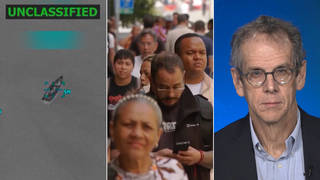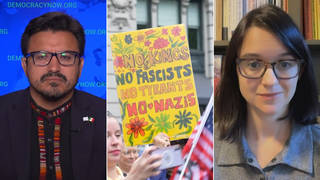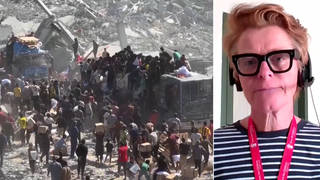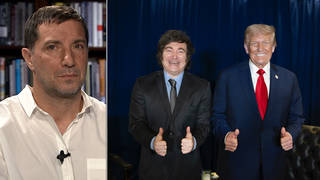
Guests
- Marc Levinaward-winning independent filmmaker and director of the new documentary, Rikers. The broadcast premiere will be on November 15 at 10 p.m on WNET Channel 13 in New York.
A new PBS documentary, “Rikers,” brings you face to face with men and women who have survived incarceration at New York City’s largest and most notorious jail. Their stories are told directly to the camera without any additional narration. A dozen former inmates vividly describe the cruel arc of the Rikers experience—from the trauma of entering the island to the extortion and control exercised by other inmates, to the harrowing interactions with corrections officers. They also detail the beatings and stabbings, the torture of solitary confinement and the psychological difficulties of re-entering the outside world. For more, we’re joined by award-winning independent filmmaker Marc Levin, director of the new documentary, “Rikers.”
Transcript
JUAN GONZÁLEZ: We spend the rest of the hour looking at New York City’s Rikers Island, one of the largest jails in the United States. On Tuesday, ABC7 here in New York aired exclusive video of a 36-year-old man named Rolando Perez, who died in his Rikers jail cell in 2014 after being denied anti-seizure medication. This is a part of ABC7’s report.
RIKERS INMATE: Let them know that the officer refused his medical attention.
CAROLINA LEID: In this exclusive video obtained by Eyewitness News, you can hear inmates telling investigators they heard Mr. Perez screaming for his medication, pills he relied on since he was 16 years old to control a severe seizure disorder. The 36-year-old died in solitary confinement after getting into a fight with another inmate. He was under arrest for petty burglary back in January 2014. He had not been convicted of a crime. An autopsy found he died of a severe seizure and heart problems.
JUAN GONZÁLEZ: Rolando Perez was being held at Rikers for the suspicion of robbing a television. His family is now suing New York City.
AMY GOODMAN: Well, we turn now to a new documentary called Rikers. It brings you face to face with men and women who have survived incarceration at New York City’s largest and most notorious jail. Their stories are told directly to the camera without any additional narration. A dozen former prisoners vividly describe the cruel arc of the Rikers experience—from the trauma of entering the island to the extortion and control exercised by other prisoners, to the harrowing interactions with corrections officers. They also detail the beatings, the stabbings, the torture of solitary confinement and the psychological difficulties of re-entering the outside world. This is the trailer for Rikers.
RAYMOND YU: It was the daytime, but it felt dark.
DAMIEN STAPLETON: It’s so much stuff going through my mind, but the main thing is hoping that I do make it out.
RAYMOND YU: It looked like a monster, like we were about to go into the belly of a beast.
SHIRAY WILLIAMS: Once you’re there—it’s easy to get there, but it’s hard as hell to get out.
RALPH NUNEZ: It’s gladiator school, for real.
MARCELL NEAL: Complete upside-down kingdom. Everything that means something to us here doesn’t mean [bleep] there.
BARRY CAMPBELL: It was total chaos. It was violence.
RALPH NUNEZ: I was scared.
KATHY MORSE: I was literally cowering in the corner.
MARCELL NEAL: The worse you do, the bigger you are.
REV. HÉCTOR BIENVENIDO CUSTODIO: I’ve seen men rape other men.
RALPH NUNEZ: If you get there and you don’t have a weapon to defend yourself, you have an issue.
CANDIE HAILEY-MEANS: I was screaming, “Help me! Help me! They’re raping me! They’re raping me!”
SHIRAY WILLIAMS: I was literally hogtied.
RAYMOND YU: They were just kicking me.
ROBERT HINTON: And broke my nose.
RAYMOND YU: And spitting on me.
ROBERT HINTON: And broke a bone on my back.
TARIQ BARNES: It’s madness.
ISMAEL NAZARIO: My sanity was chipped away, little by little.
RALPH NUNEZ: Solitary confinement is rough, man. You can really go crazy.
REV. HÉCTOR BIENVENIDO CUSTODIO: You start befriending the roaches and the rats.
MARCELL NEAL: I started to feel like an animal.
REV. HÉCTOR BIENVENIDO CUSTODIO: I actually contemplated suicide.
My name is Reverend Héctor Bienvenido Custodio.
ISMAEL NAZARIO: Ismael Nazario.
DAMIEN STAPLETON: Damien James Stapleton.
KATHY MORSE: Kathy Morse.
MARCELL NEAL: Marcell Neal.
BARRY CAMPBELL: Barry Campbell.
RAYMOND YU: Raymond Yu.
RALPH NUNEZ: For all of you who have been here, you already know what to expect. For those of you who have not been here before, tighten your pants.
AMY GOODMAN: That was the trailer for the new public television WNET 13 documentary Rikers. It will have its broadcast premiere on November 15th here in New York City on channel 13, public television in New York.
For more, we’re joined by the award-winning independent filmmaker Marc Levin, director of the new documentary Rikers.
Marc Levin, welcome to Democracy Now! You worked with Bill Moyers and Mark Benjamin on this film. Talk about what this film is all about. What inspired you to do this?
MARC LEVIN: Well, this was really an idea of Bill’s, who I’ve known for many years. But the basic idea was, as you said, face to face, to hear for the first time exclusively from people who had survived Rikers Island, without any news people interfering or officials or politicians. It’s really to hear them. And I would say it’s really—Rikers is a symbol of, obviously, a criminal justice system that is dysfunctional. And we have this idea of criminals, and we’ve criminalized so many people. I mean, that’s what the documentary 13th was about. And here you have a chance to kind of humanize, rehumanize: Who are these people that we’re putting away? And as you just said in the tragic report you just had up there, 80 percent of them have not even been convicted of a crime yet. They’re waiting to see, either to go to trial or plea bargain. So, that was the idea of this film, is to allow people to experience what it’s like to be on Rikers Island.
JUAN GONZÁLEZ: And how did you decide on the inmates that you would use in the film, the process of making it?
MARC LEVIN: Well, with my partner Mark Benjamin and our producer Rolake Bamgbose, we probably met over a hundred people who had been on Rikers between the late ’70s and all the way to this year. And out of that, just a natural kind of winnowing down to about 12 who ended up being the main characters. But we talked to, obviously, a lot of people.
AMY GOODMAN: Let’s go to a clip of Rikers where former detainees describe the culture of violence there.
RALPH NUNEZ: It’s gladiator school, for real. If you get there and you don’t have a weapon to defend yourself, you have an issue.
BARRY CAMPBELL: Violence rules. Predator-prey. That [bleep] never changes.
DEDRIC HAMMOND: I’m in a situation where I can’t run from. But my whole time in the streets, that’s all I ever been doing, is fighting. So I’m looking like I’m in a place where I always trained for but just didn’t know it.
MYSONNE LINEN: The sad part is, the alternative to violence is more violence. And when somebody realizes that you’re willing to be more violent than they are, they are less the prone to be violent.
MARCELL NEAL: They taught me how to use a level of violence that I’ve never—I could never imagine I was capable of doing.
AMY GOODMAN: Talk about this, Marc Levin.
MARC LEVIN: Well, I think this is one of the main issues. We think we’re putting people away on this penal colony, and out of sight, out of mind, but basically it’s a university of crime. It’s an accelerant of misery. It makes things worse. The price we’re paying—we talk about the cost, but the price we’re paying, in terms of sending young people, mostly young people of color, away and them coming out worse off than they went. If they’re going to survive, they’ve got to be part of this notorious culture of violence. And that is frightening.
JUAN GONZÁLEZ: And, Marc Levin, one of the—the culture of violence that you mention, obviously, the prison guards themselves have to have been major participants in allowing this to happen. One of the interesting things that I’ve always found fascinating is that the Correction Officers’ Association there is a very powerful institution. It’s largely African-American and Latino corrections officers. The leader, Norman Seabrook, was just indicted by federal authorities on corruption charges and ousted. But Norman Seabrook wielded enormous power in protecting his members, the members of his union, from any kinds of charges against the kind of brutality that is so rampant at Rikers.
MARC LEVIN: Absolutely, Juan. I mean, that’s one of the issues that officials are struggling with now. I think they’ve made some progress. As you know, there was a trial recently where a number of officers were convicted for abuses. As you said, Seabrook himself has been indicted. It’s a struggle, because the irony is that many of the corrections officers are from the same communities. Sometimes even they know or are related to, as, in our film Rikers, Marcell Neal talks about his relatives who were corrections officers and how he used to wink and kind of hide that he was related to people. So, it’s a complex situation, but there’s no doubt that changing the culture of violence means changing how corrections officers are trained and disciplined.
AMY GOODMAN: How—what is the history of Rikers?
MARC LEVIN: The history? It’s a landfill that, you know—
AMY GOODMAN: In the East River.
MARC LEVIN: Yeah, exactly. I mean, that’s a—you know, that’s the big question right now, is: Is the history so cursed and the karma of this place just so dark, that it can’t be changed and it’s got to be closed down? And certainly a lot of advocates feel that way. Or can it be so—can we reduce the number of detainees there so much that it doesn’t make financial sense anymore to run an institution there?
JUAN GONZÁLEZ: There has been a sharp reduction in the inmate population, right?
MARC LEVIN: Absolutely.
JUAN GONZÁLEZ: At one point it was around 16,000. Now it’s down.
MARC LEVIN: The peak was almost 18,000 to 20,000 during the crack era, late '80s and early ’90s. It's now down to about 7,500. So, I mean, I think that’s the key thing here. First, how do you prevent people—you just mentioned the guy that robbed the television set. He’s dead now. How do you prevent people like that? What are alternative sentences? Two, what kind of bond bail reform is needed, so somebody—I know you’re going to have Kalief’s brother in here—for bail of a few hundred dollars to a few thousand dollars, can get that money and doesn’t end up being locked up? Then, what kind of programming do you have for people who are locked up there, many of them with mental health issues? And finally, on the re-entry side, what do you do when people get out and who have had to survive that?
AMY GOODMAN: Let’s go to another clip from the documentary Rikers.
MARCELL NEAL: When I became a Blood, now it was more so I had an authority. Now I am the authority. And that culture is just very much different, because it’s like the worse you do, the bigger you are. At that point, we weren’t the strongest. We weren’t the most—it was a gang that was bigger than us. There was a Hispanic gang, the Latin Kings. They were the majority. We were the minority. I ended up putting a lot to work. And by putting to work, I mean a lot of physical contact, a lot of violence, a lot of stabbings, a lot of cuttings. So now, when I say jump, that was for real. That was you’re going to jump. And if you don’t do it, I’ve got 35 other people in here that’s going to make you do it.
REV. HÉCTOR BIENVENIDO CUSTODIO: When the Bloods relocated, they was putting fear in a lot of people. It was very few of our people who stood their ground.
FIVE MUALIMM-AK: And it became this whole type of system that was with the Latin gangs 10 years prior, was now with the Bloods and the Crips and other gangs, where they had control and the officers gave them power, gave them drugs, gave them influence, right? And the COs always was the oppositional gang. Whether they was a secret member of this gang, they was an entire gang themselves. And that’s the way they portrayed themselves.
NARRATION: There is a uniformed officer for nearly every detainee at New York City jails.
DAMIEN STAPLETON: There’s a saying that it doesn’t matter if you have a uniform on—right?—which is that says “correction officer” or one that says “inmate.” You’re still doing time.
JASBIR SINGH: Well, being an inmate and being a CO is like a very thin line. Time stops for them, too, when they come to Rikers Island. There’s only one bridge in and one bridge out. There’s some COs that are real cool. You know, there are some COs that really understand the system, and they try to prevent these young people from coming back by talking to them.
DAMIEN STAPLETON: The majority of the officers on Rikers Island are minorities. They come from where we come from. They grew up where we grew up at. Somehow they just never made it to prison.
MARCELL NEAL: My aunts and my sister, captives on Rikers Island. And my dad and my mom, federal court officers. Because I couldn’t tell anybody I was related to this person, I would just see, you know, family in the corridor while I’m going to eat, and just give them the wink.
JOHNNY PEREZ: You know, I done bought drugs from correction officers, who told me they’re going to send me to the box if I don’t pay them, you know, things like that. And all of that made me say, “Well, you know, you’re just like me. You know, we’re all criminals in here.”
AMY GOODMAN: That’s an excerpt of the film Rikers, that will premiere on public television WNET, channel 13 in New York, on November 15th and at DOC NYC, the film festival in New York, on November 12th. Marc Levin is the award-winning independent filmmaker who directed this film. We’ll be back with him, as well as a young man who you’ve heard a good deal about on Democracy Now!, he’s died, but his brother, Kalief Browder’s brother Akeem. Thanks so much for being with us. We’ll be back in a minute.












Media Options